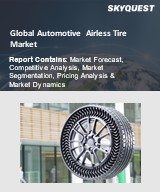
Report ID: SQMIG25A2276

Report ID:
SQMIG25A2276 |
Region:
Global |
Published Date: March, 2024
Pages:
225
|
Tables:
118 |
Figures:
74
Automotive Airless Tire Market Drivers
Rising Demand for Maintenance Free Tires
Advances In Vehicle Safety and Maintenance
Automotive Airless Tire Market Restraints
Low Performance During Friction and High-speed Conditions
Production Complexity and Cost Considerations
Our industry expert will work with you to provide you with customized data in a short amount of time.
REQUEST FREE CUSTOMIZATIONWant to customize this report? This report can be personalized according to your needs. Our analysts and industry experts will work directly with you to understand your requirements and provide you with customized data in a short amount of time. We offer $1000 worth of FREE customization at the time of purchase.

Report ID: SQMIG25A2276